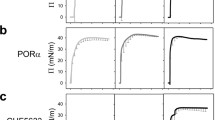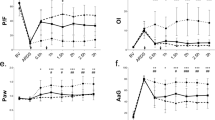Abstract
Surfactant preparations, which are effective in the treatment of respiratory distress syndrome (RDS), contain phospholipids and small amounts of the 2 hydrophobic surfactant proteins SP-B and SP-C. At present, surfactant preparations are obtained from animal lungs. However, since information concerning the structure of SP-B and SP-C is now available, it appears possible to design analogues that can replace the native proteins and so formulate a synthetic peptide/lipid surfactant. This would circumvent problems associated with current purification procedures and also facilitate the production of quantities sufficient for evaluation of surfactant therapy in other respiratory diseases.
SP-C analogues which effectively accelerate the spreading of surfactant lipids and exhibit physiological activity in animal models of RDS have been developed. However, the in vivo activity of surfactant preparations based on SP-C analogues are inferior to those of surfactant preparations derived from natural sources. This may be caused by lack of covalently linked palmitoyl groups in the SP-C analogues tested and/or that SP-B is required for full activity.
The larger size of SP-B compared to SP-C makes the design of SP-B analogues more demanding. Surfactant preparations containing single peptides that may resemble SP-B have shown promising results in vitro and in vivo. Identification of further SP-B analogues as well as suitable combinations of SP-B and SP-C analogues appear to be important topics for future studies.
Similar content being viewed by others
References
Boncuk-Dayanikli P, Taeusch HW. Essential and nonessential constituents of exogenous surfactants. In: Robertson B, Taeusch HW, editors. Surfactant therapy for lung disease. New York: Marcel Dekker, 1995: 217–38
Nogee LM, deMello DE, Dehner LP, et al. Pulmonary surfactant protein B deficiency in congenital pulmonary alveolar pro-teinosis. N Engl J Med 1993; 328: 406–10
Clark JC, Wert SE, Bachurski CJ, et al. Targeted disruption of the surfactant protein B gene disrupts surfactant homeostasis, causing respiratory failure in newborn mice. Proc Natl Acad Sci U S A 1995; 92: 7794–8
Robertson B, Kobayashi T, Ganzuka M, et al. Experimental neonatal respiratory failure induced by a monoclonal antibody to the hydrophobic surfactant-associated protein SP-B. Pediatr Res 1991; 30: 239–43
Kobayashi T, Nitta K, Takahashi R, et al. Activity of pulmonary surfactant after blocking the associated proteins SP-A and SP-B. J Appl Physiol 1991; 71: 530–6
Suzuki Y, Robertson B, Fujita Y, et al. Respiratory failure in mice caused by a hybridoma making antibodies to the 15 kDa surfactant apoprotein. Acta Anaesthesiol Scand 1988; 32: 283–9
Robertson B. Experimental models for evaluation of exogenous surfactants. In: Robertson B, Taeusch HW, editors. Surfactant therapy for lung disease. New York: Marcel Dekker, 1995: 239–68
Johansson J, Curstedt T. Molecular structures and interactions of pulmonary surfactant components. Eur J Biochem 1997; 244: 675–93
Andersson M, Curstedt T, Jörnvall H, et al. An amphipathic helical motif common to tumourolytic polypeptide NK-lysin and pulmonary surfactant polypeptide SP-B. FEBS Lett 1995; 362: 328–32
Revak SD, Merritt TA, Hallman M, et al. The use of synthetic peptides in the formation of biophysically and biologically active pulmonary surfactants. Pediatr Res 1991; 29: 460–5
Baatz JE, Sarin V, Absolom DR, et al. Effects of surfactant-associated protein SP-B synthetic analogs on the structure and surface activity of model membrane bilayers. Chem Phys Lipids 1991; 60: 163–78
Bruni R, Taeusch HW, Waring AJ. Surfactant protein B: lipid interactions of synthetic peptides representing the amino-ter-minal amphipathic domain. Proc Natl Acad Sci U S A 1991; 88: 7451–5
Lipp MM, Lee KYC, Zasadzinski JA, et al. Phase and morphology changes in lipid monolayers induced by SP-B protein and its amino-terminal peptide. Science 1996; 273: 1196–9
Gordon LM, Horvath S, Longo ML, et al. Conformational and molecular topography of the N-terminal segment of surfactant protein B in structure-promoting environments. Protein Science 1996; 5: 1662–75
McLean LR, Lewis JE, Krstenansky JL, et al. An amphi-pathic α-helical decapeptide in phosphatidylcholine is an effective synthetic lung surfactant. Am Rev Respir Dis 1993; 147: 462–5
Nilsson G, Gustafsson M, Vandenbussche G, et al. Synthetic peptide-containing surfactants: evaluation of transmembrane versus amphipathic helices and SP-C poly-valyl to poly-leucyl substitution. Eur J Biochem 1998; 255: 116–24
Cochrane CG, Revak SD. Pulmonary surfactant protein B (SP-B): structure-function relationships. Science 1991; 254: 566–8
Merritt TA, Kheiter, A, Cochrane CG. Positive end-expiratory pressure during KL4 surfactant instillation enhances in-trapulmonary distribution in a simian model of respiratory distress syndrome. Pediatr Res 1995; 38: 211–7
Revak SD, Merritt TA, Cochrane CG, et al. Efficacy of synthetic peptide-containing surfactant in the treatment of respiratory distress syndrome in preterm infant rhesus monkeys. Pediatr Res 1996; 39: 715–24
Cochrane CG, Revak SD, Merritt TA, et al. The efficacy and safety of KL4 -surfactant in preterm infants with respiratory distress syndrome. Am J Respir Crit Care Med 1996; 153: 404–10
Walther FJ, Hernández-Juviel J, Bruni R, et al. Spiking Survanta with synthetic surfactant peptides improves oxygenation in surfactant-deficient rats. Am J Respir Crit Care Med 1997; 156: 855–61
Gustafsson M, Vandenbussche G, Curstedt T, et al. The 21-res- idue surfactant peptide (LysLeu4 )4 Lys (KL4 ) is a transmem-brane ot-helix with a mixed nonpolar/polar surface. FEBS Lett 1996; 383: 185–8
Johansson J, Szyperski T, Wüthrich K. Pulmonary surfactant-associated polypeptide SP-C in lipid micelles: CD studies of intact SP-C and NMR secondary structure determination of depalmitoyl-SP-C (1-17). FEBS Lett 1995; 362: 261–5
Johansson J, Nilsson G, Strömberg R, et al. Secondary structure and biophysical activity of synthetic analogues of the pulmonary surfactant polypeptide SP-C. Biochem J 1995; 307: 535–41
Qanbar R, Cheng S, Possmayer F, et al. Role of palmitoylation of surfactant-associated protein C in surfactant film formation and stability. Am J Physiol 1996; 271: L572–80
Wang Z, Gurel O, Baatz JE, et al. Acylation of pulmonary surfactant protein-C is required for its optimal surface active interactions with phospholipids. J Biol Chem 1996; 271: 19104–9
Voss T, Schäfer KP, Nielsen PF, et al. Primary structure differences of human surfactant-associated proteins isolated from normal and proteinosis lung. Biochim Biophys Acta 1992; 1138: 261–7
Takei T, Hashimoto Y, Aiba T, et al. The surface properties of chemically synthesized peptides analogous to human pulmonary surfactant protein SP-C. Biol Pharm Bull 1996; 19: 1247–53
Clercx A, Vandenbussche G, Curstedt T, et al. Structural and functional importance of the C-terminal part of the pulmonary surfactant polypeptide SP-C. Eur J Biochem 1995; 228: 465–72
Takei T, Hashimoto Y, Ohtsubo E, et al. Characterization of poly-leucine substituted analogues of human surfactant protein SP-C. Biol Pharm Bull 1996; 19: 1550–5
Hawgood S, Ogawa A, Yukitake K, et al. Lung function in premature rabbits treated with recombinant human surfactant protein-C. Am J Respir Crit Care Med 1996; 154: 484–90
Cockshutt AM, Weitz J, Possmayer F. Pulmonary surfactant-associated protein A enhances the surface activity of lipid extract surfactant and reverses inhibition by blood proteins in vitro. Biochemistry 1990; 29: 8424–9
van Iwaarden F, Welmers B, Verhoef J, et al. Pulmonary surfactant protein A enhances the host-defense mechanism of rat alveolar macrophages. Am J Respir Cell Mol Biol 1990; 2: 91–8
Manalo E, Merritt TA, Kheiter A, et al. Comparative effects of some serum components and proteolytic products of fibrinogen on surface tension-lowering abilities of Beractant and a synthetic peptide containing surfactant KL4. Pediatr Res 1996; 39: 947–52
Author information
Authors and Affiliations
Corresponding author
Rights and permissions
About this article
Cite this article
Johansson, J., Gustafsson, M., Palmblad, M. et al. Pulmonary Surfactant. BioDrugs 11, 71–77 (1999). https://doi.org/10.2165/00063030-199911020-00001
Published:
Issue Date:
DOI: https://doi.org/10.2165/00063030-199911020-00001




